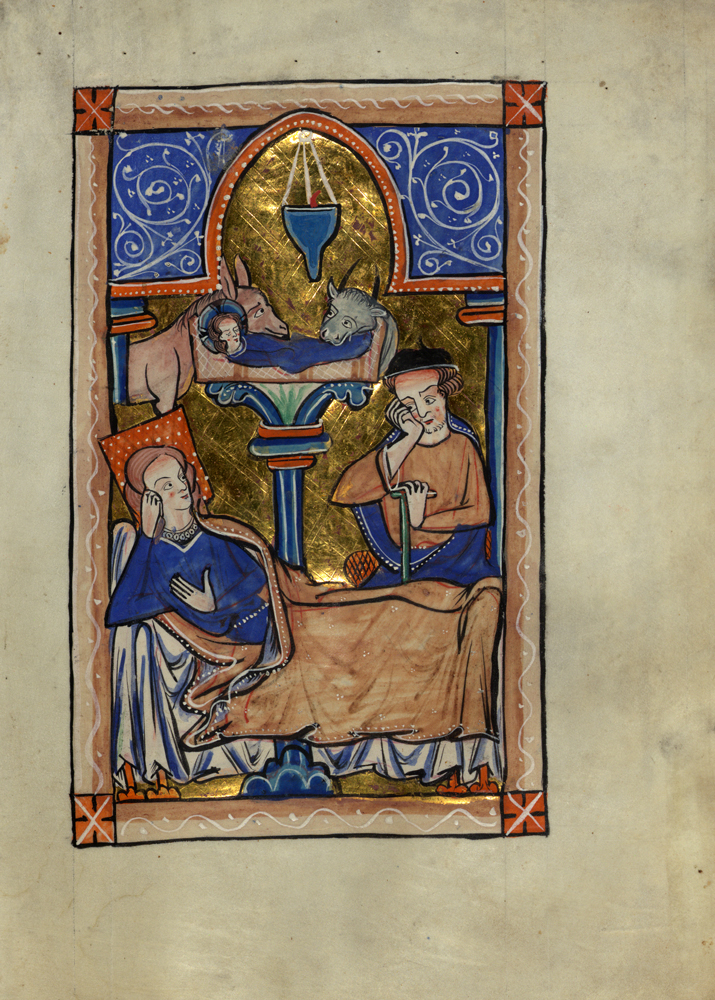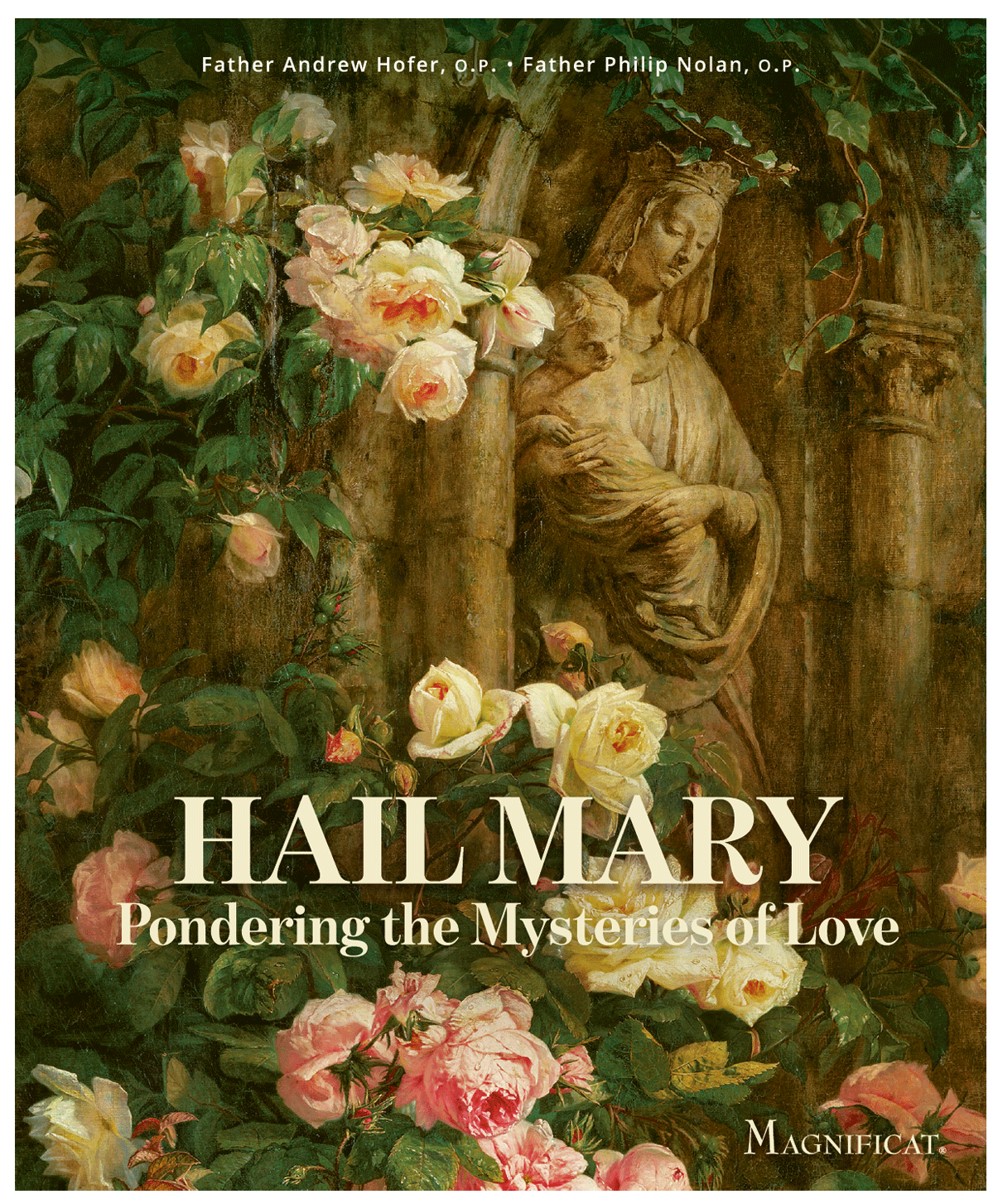Nativity (c. 1250) from The Carrow Psalter,
Anonymous English Master.
In the novel Brideshead Revisited, the English author and Catholic convert Evelyn Waugh portrays a conversation between two characters illustrating the challenges as well as the joys of living the Catholic faith. The first speaker in this scene, the (as yet) agnostic Charles Ryder, is bewildered by the childlike faith of the cradle Catholic Sebastian Flyte.
“But my dear Sebastian, you can’t seriously believe it all.”
“Can’t I?”
“I mean about Christmas and the star and the three kings and the ox and the ass.”
“Oh yes, I believe that. It’s a lovely idea.”
“But you can’t believe things because they’re a lovely idea.”
“But I do. That’s how I believe.”
In this passage, Waugh expresses a perennial insight of the Christian tradition: beauty helps us come to the knowledge of the truth. “In addition to the expression of the truth in words there are other complementary expressions of the truth, most specifically in the beauty of artistic works… Sacred art by being true and beautiful should evoke and glorify the mystery of God made visible in Christ, and lead to the adoration and love of God, the Creator and Savior, who is the surpassing, invisible Beauty of Truth and Love” (Compendium of the Catechism of the Catholic Church, §526). As Cardinal Ratzinger once famously declared, “the only really effective apologia for Christianity comes down to two arguments, namely the saints the Church has produced and the art which has grown in her womb.”
In Waugh’s novel, the agnostic Charles expresses scorn for the iconography associated with the Nativity and Epiphany of Christ: “Christmas and the star and the three kings and the ox and the ass.” In the Carrow Psalter, a manuscript produced in East Anglia in the mid-13th century and later owned by the Benedictine nuns of Carrow Abbey near Norwich, all these elements are on vivid display. On the leaf depicted here, the Ox and the Ass cheerfully nestle the infant Jesus, who sleeps peacefully in the manger, wrapped tightly in a blue cloth that could have been cut from the gown of the Virgin Mary or the cloak of Saint Joseph. The Nativity scene faces the Annunciation, while on the following pages the star and the three kings appear in an Epiphany scene paired with the Presentation of Christ in the Temple. A great serenity pervades these scenes. The invisible God has been made visible in the Incarnation of Jesus Christ, and the loveliness of the paintings draws us into the contemplation of these mysteries.
In the Gospel of Luke, the birth of Christ is described with loving detail that nevertheless leaves much room for our imagination: While they were there, the time came for her to have her child, and she gave birth to her firstborn son. She wrapped him in swaddling clothes and laid him in a manger, because there was no room for them in the inn (Lk 2:6-7). Notably lacking from this account is the ox and the ass cherished by Sebastian Flyte. In the Christian artistic tradition, these figures are drawn from the opening chapter of the Prophet Isaiah: An ox knows its owner, and an ass, its master’s manger (Is 1:3).
The iconography of the Nativity in the Carrow Psalter is deeply traditional, but is presented with an imaginativeness that draws us into the scene. The most striking feature is the eyes. Mary and Joseph gaze at one another with wide-open wonder. The ox looks adoringly at the child, while the ass looks away, keeping guard with upright ears. The postures of Mary and Joseph are likewise paired; each rests their head on their right hand, and both take advantage of luxuriant pillows. Mary reclines on an improvised camp bed, the contours of her legs clearly defined under an abundant mantel serving as an improvised blanket. In contrast to the veiled Virgin in the paired Annunciation, Mary’s free-flowing hair gives a sense of domestic intimacy and ease in the midst of the indignities of the barn.
Although many medieval Nativity scenes include the iconographic elements found here, the mode of arrangement can differ greatly. In a Nativity that appears in a separate cycle earlier in the Carrow Psalter, Christ’s crib is at the bottom of the frame, with Mary and Joseph appearing at the center. Here, the Christ Child’s crib is raised to a more prominent place in the upper portion of the frame, resting on a pedestal at the top of a column that is perplexingly both behind and in front of Mary’s bed. The arrangement of Mary, the column, and the crib calls to mind the Tree of Jesse, in which a branch rises up from a sleeping figure depicting Christ’s genealogy. Here, the capital of the column takes on branch-like features, and the extension both above and below the Virgin reminds us that Mary is connected both to her own ancestors and to her singular descendant.
At the top of the scene, a burning lamp hangs from three chains flowing from a single loop, suggesting the singular nature of the three Persons of the Trinity and reminding the viewer of a lamp burning before a Eucharistic tabernacle—a small red flame burning among the old stones, recalling that in the Incarnation, the true light, which enlightens everyone, was coming into the world (Jn 1:9). And the Word became flesh and made his dwelling among us, and we saw his glory, the glory as of the Father’s only Son, full of grace and truth (Jn 1:14).
In the Incarnation, the invisible God has been made visible, so that “we may be caught up through him in love of things invisible” (Christmas Preface). By contemplating this depiction of the newborn Christ, we are led through the beauty of the outward forms to an encounter with the source of spiritual beauty itself. “Radiant light will shine upon us today, for the Lord is born unto us. He shall be called Wonderful God, Prince of Peace, Father of the world to come. His reign shall have no end” (Introit, Mass at Dawn).
Father Innocent Smith, O.P.
Dominican friar of the Province of Saint Joseph and
professor at the Dominican House of Studies in Washington, DC.
He is the author of Bible Missals and the Medieval Dominican Liturgy.
Nativity (c. 1250) from The Carrow Psalter, Anonymous English Master, Walters Art Museum, Baltimore. © Image: CC0.1.0












Additional art commentaries